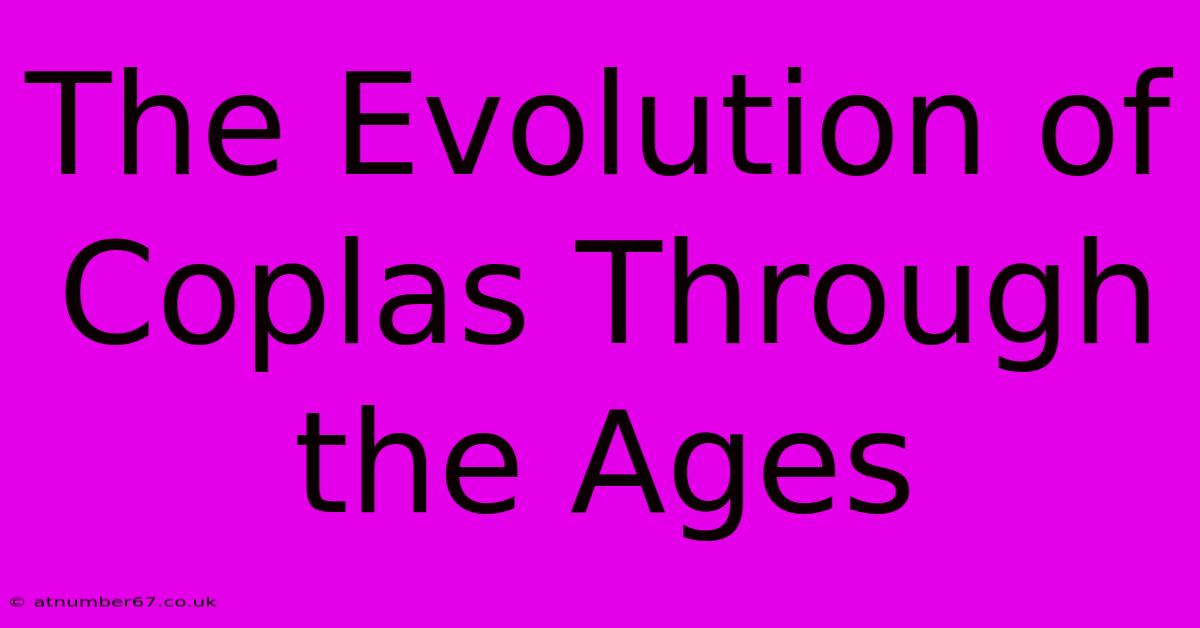The Evolution Of Coplas Through The Ages

Table of Contents
The Evolution of Coplas Through the Ages
The coplas, a vibrant form of Spanish poetry, boasts a rich history, evolving and adapting across centuries while retaining its core essence. Understanding its evolution reveals not only a fascinating literary journey but also a reflection of societal shifts and cultural transformations in Spain and beyond. From its medieval origins to its modern interpretations, the coplas continue to resonate with audiences, proving its enduring power and adaptability.
Medieval Roots: The Dawn of the Copla
The earliest forms of coplas emerged during the medieval period, often intertwined with folk traditions and oral poetry. These early examples lacked the formal structure that would later define the genre. They were characterized by simplicity of language, focusing on themes of love, nature, and everyday life. Think of them as the poetic building blocks upon which later, more complex structures would be built. These early coplas, passed down through generations, laid the foundation for the later, more refined forms.
Key Characteristics of Early Coplas:
- Simple rhyme schemes: Often utilizing assonance rather than perfect consonance.
- Short lines: Making them easily memorized and disseminated orally.
- Focus on everyday themes: Reflecting the lives and concerns of ordinary people.
The Golden Age: Structure and Refinement
The Spanish Golden Age (roughly the 16th and 17th centuries) witnessed a significant development in the coplas' form and artistic merit. Poets like Jorge Manrique, with his famous Coplas a la muerte de su padre, elevated the coplas to a higher literary plane. Manrique's work, a deeply moving lament for his father, established a new standard for the genre, demonstrating its capacity for profound emotional expression and philosophical reflection.
Defining Features of Golden Age Coplas:
- More complex rhyme schemes: Introducing intricate patterns and a higher level of formal structure.
- Sophisticated language: Utilizing richer vocabulary and more nuanced imagery.
- Exploration of deeper themes: Delving into mortality, faith, and the human condition.
This era saw the standardization of the coplas form, solidifying its place within the canon of Spanish literature. It became a vehicle for exploring a wider range of emotions and themes, showcasing the genre's versatility and power.
The Romantic and Modern Eras: Adaptation and Innovation
The Romantic movement and subsequent modern periods brought about further changes. While the basic structure remained relatively consistent, the themes and styles underwent considerable evolution. Romantic poets infused coplas with heightened emotionality and a focus on individual experience. Later, modernist and contemporary poets experimented with form and style, pushing the boundaries of traditional coplas while preserving the core elements that define the genre.
Modern Adaptations and Innovations:
- Experimentation with form: Some poets have played with line length and rhyme schemes, creating variations on the traditional structure.
- Exploration of contemporary themes: Modern coplas often grapple with issues relevant to the 20th and 21st centuries.
- Use of diverse language: Reflecting the changing linguistic landscape of Spain and the Spanish-speaking world.
The Enduring Legacy of the Copla
The coplas, despite its evolution, maintains a vital presence in Spanish culture. Its adaptability has allowed it to survive and thrive across centuries. Its enduring appeal lies in its ability to connect with audiences on an emotional level, conveying complex ideas and experiences through a relatively simple yet powerful poetic form. From its humble beginnings as oral tradition to its sophisticated literary expressions, the coplas continue to inspire and captivate, ensuring its legacy will endure for generations to come. Its adaptability and continuing relevance demonstrate its powerful position within the landscape of Spanish poetry. The copla's journey mirrors the evolution of Spanish culture itself, a testament to its enduring strength and artistic merit.

Thank you for visiting our website wich cover about The Evolution Of Coplas Through The Ages. We hope the information provided has been useful to you. Feel free to contact us if you have any questions or need further assistance. See you next time and dont miss to bookmark.
Featured Posts
-
The Lavish Celebration Kumar Vishwas Daughters Marriage
Apr 02, 2025
-
The Son Who Defies Rambos Legacy
Apr 02, 2025
-
Pinky Dhaliwals Son Making His Mark
Apr 02, 2025
-
Maguy Bou Ghosns Age A Celebration Of Life
Apr 02, 2025
-
The Age Of Disclosure Trailer A Glimpse Into The Future
Apr 02, 2025
